Roman numerals

Roman numerals

Roman numerals are a numeral system that originated in ancient Rome and remained the usual way of writing numbers throughout Europe well into the Late Middle Ages. Numbers in this system are represented by combinations of letters from the Latin alphabet. Modern usage employs seven symbols, each with a fixed integer value:[4]
The use of Roman numerals continued long after the decline of the Roman Empire. From the 14th century on, Roman numerals began to be replaced in most contexts by the more convenient Arabic numerals; however, this process was gradual, and the use of Roman numerals persists in some minor applications to this day.
One place they are often seen is on clock faces. For instance, on the clock of Big Ben (designed in 1852), the hours from 1 to 12 are written as:
- **I, II, III, IV, V, VI, VII, VIII, IX, X, XI, XII**
The notations IV and IX can be read as "one less than five" (4) and "one less than ten" (9), although there is a strong tradition favouring representation of "4" as "IIII" on Roman numeral clocks.[5]
Other common uses include year numbers on monuments and buildings and copyright dates on the title screens of movies and television programs. MCM, signifying "a thousand, and a hundred less than another thousand", means 1900, so 1912 is written MCMXII. For this century, MM indicates 2000. Thus the current year is MMXIX (2019).
Description
There is not, and never has been, an "official", "binding", or universally accepted standard for Roman numerals.[1] Usage in ancient Rome varied greatly and remained somewhat inconsistent in medieval times and later.[7] The "rules" of the system as it is now applied have been established only by general usage over the centuries.
A "base 10" system
Roman numerals are essentially a decimal or "base 10" number system. Powers of ten – thousands, hundreds, tens and units – are written separately, from left to right, in that order. In the absence of "place keeping" zeros, different symbols are used for each power of ten, but a common pattern is used for each of them.
The underlying form of this pattern employs the symbols I and V (representing 1 and 5) as simple tally marks, to build the numbers from 1 to 9. Each marker for 1 (I) adds a unit value up to 5 (V), and is then added to (V) to make the numbers from 6 to 9. Finally the unit symbol for the next power completes a "finger count" sequence:
- **I, II, III, IIII, V, VI, VII, VIII, VIIII, X**.
At some early time the Romans started to use the abbreviated forms IV ("one less than 5") for IIII and IX ("one less than 10") for VIIII - a convention that has been widely, although not universally, used ever since.[2] This convention is called "subtractive" notation,[8] as opposed to the purely "additive" notation of IIII and VIIII.[9] Thus the numbers from 1 to 10 are generally written as
- **I, II, III, IV, V, VI, VII, VIII, IX, X**.[10]
The multiples of 10, from 10 to 100, are written according to the same pattern, with X, L, and C taking the place of I, V, and X
- **X, XX, XXX, XL, L, LX, LXX, LXXX, XC, C**.
Note that 40 is usually written XL ("10 less than 50") rather than XXXX, and 90 as XC ("10 less than 100") rather than LXXXX.
Similarly, the multiples of 100, 100 to 1000, are written as
- **C, CC, CCC, CD, D, DC, DCC, DCCC, CM, M**.
where CD is to be read as "100 less than 500" (that is, 400), and CM as "100 less than 1000" (that is, 900).
Since the system has no standard symbols for 5,000 and 10,000, the full pattern cannot be extended to the multiples of 1000 – restricting the "thousands" range of "normal" Roman numerals to 1,000, 2,000 and 3,000:
- **M, MM, MMM.**
A number containing several decimal places is represented, as in the Arabic system, by writing its power-of-ten parts — thousands, hundreds, tens and units — in sequence, from left to right, in descending order of value. For example:
39 = 30 + 9 = XXX + IX = XXXIX.
246 = 200 + 40 + 6 = CC + XL + VI = CCXLVI.
789 = 700 + 80 + 9 = DCC + LXXX + IX = DCCLXXXIX.
2,421 = 2000 + 400 + 20 + 1 = MM + CD + XX + I = MMCDXXI.
Any missing place (represented by a zero in the Arabic equivalent) is omitted, as in Latin (and English) speech:
Roman numerals for large numbers are nowadays seen mainly in the form of year numbers, as in these examples:
1776 = 1,000 + 700 + 70 + 6 = M + DCC + LXX + VI = MDCCLXXVI (the date written on the book held by the Statue of Liberty).[13]
1954 = 1,000 + 900 + 50 + 4 = M + CM + L + IV = MCMLIV (as in the trailer for the movie The Last Time I Saw Paris)[6]
2014 = 2,000 + 10 + 4 = MM + X + IV = MMXIV (the year of the games of the XXII (22nd) Olympic Winter Games (in Sochi)
The current year (2019) is MMXIX.
The largest number that can be represented in this notation is 3,999 (3,000 + 900 + 90 + 9 = MMM + CM + XC + IX = MMMCMXCIX).[3]
Variant forms
Forms exist that vary in one way or another from the general "standard" described above.
Use of additive notation

A typical clock face with Roman numerals in Bad Salzdetfurth, Germany

The year number on Admiralty Arch, London (1910). Rendered as MDCCCCX, rather than the more usual MCMX
While subtractive notation for multiples of 4 (IV, XL and CD) has been the usual form since Roman times, additive notation (IIII, XXXX,[14] and CCCC[14]) continued to be used, including in compound numbers like XXIIII,[15] LXXIIII,[16] and CCCCLXXXX.[17] The additive forms for 9, 90, and 900 (VIIII,[14]LXXXX,[18] and DCCCC[19]) have also been used, although less frequently.
The two conventions could be mixed in the same document or inscription, even in the same numeral. On the numbered gates to the Colosseum, for instance, IIII is systematically used instead of IV, but subtractive notation is used for other digits; so that gate 44 is labelled XLIIII.[20] Isaac Asimov speculates that the use of IV, as the initial letters of "IVPITER" (a classical Latin spelling of the name of the Roman god Jupiter) may have been felt to have been impious in this context.[21]
Modern clock faces that use Roman numerals still usually employ IIII for four o'clock but IX for nine o'clock, a practice that goes back to very early clocks such as the Wells Cathedral clock of the late 14th century.[22][23][24] However, this is far from universal: for example, the clock on the Palace of Westminster tower, "Big Ben", uses a subtractive IV for 4 o'clock.[23]
Several monumental inscriptions created in the early 20th century use variant forms for "1900" (usually written MCM). These vary from MDCCCCX - a classical use of additive notation for MCMX (1910), as seen on Admiralty Arch, London, to the more unusual, if not unique MDCDIII for MCMIII (1903), on the north entrance to the Saint Louis Art Museum.[25]
Irregular subtractive notation
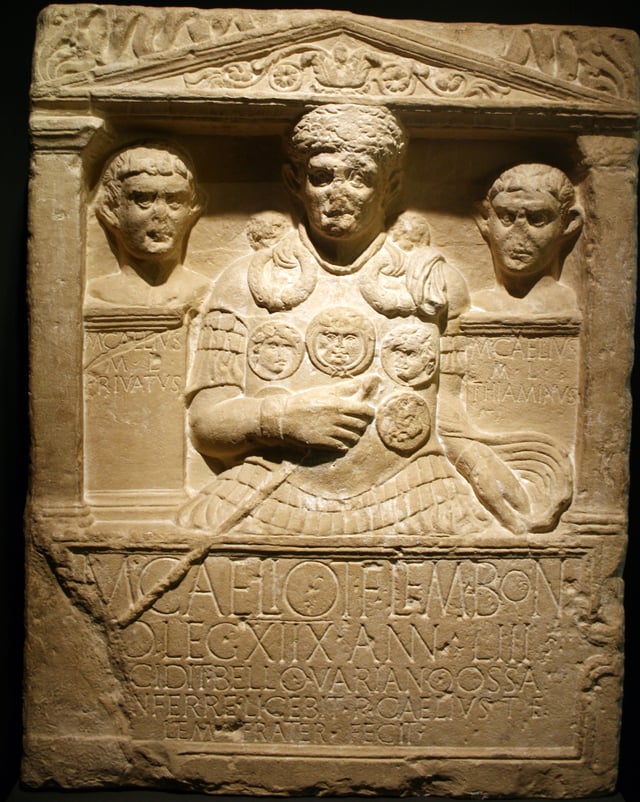
Epitaph of centurion Marcus Caelius, showing "XIIX"
The irregular use of subtractive notation, such as IIIXX for 17,[28] IIXX for 18,[29] IIIC for 97,[30] IIC for 98,[31][32] and IC for 99[33] were occasionally used in more modern times. A possible explanation is that the word for 18 in Latin was duodeviginti, literally "two from twenty". Similarly, the words for 98 and 99 were duodecentum (two from hundred) and undecentum (one from hundred), respectively.[34] These ways of saying 18, 98 and 99 have been attributed to influence from the Etruscans, who would say ciem zaθrum (three from twenty) for 17, eslem zaθrum (two from twenty) for 18 and θunem zaθrum (one from twenty) for 19.[35] However, the explanation does not seem to apply to IIIXX and IIIC, since the Latin words for 17 and 97 were septendecim (seven ten) and nonaginta septem (ninety seven), respectively.
Another example of irregular subtractive notation is the use of XIIX for 18. It was used by officers of the XVIII Roman Legion to write their number.[36][37] The notation appears prominently on the cenotaph of their senior centurion Marcus Caelius (c. 45 BC – AD 9). There does not seem to be a linguistic explanation for this use, although it is one stroke shorter than XVIII.
Rare variants
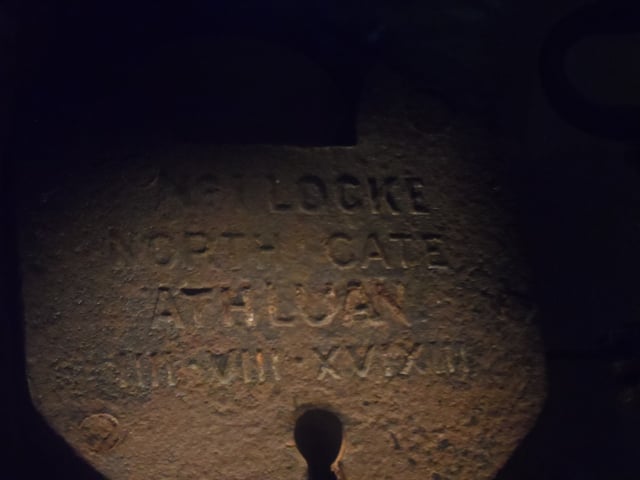
Padlock used on the north gate of the Irish town of Athlone. "1613" in the date is rendered XVIXIII, (literally "16, 13") instead of MDCXIII

Excerpt from Bibliothèque nationale de France.[39] The Roman numeral for 500 is rendered as VC, instead of D
While the subtractive and additive notations seem to have been used interchangeably through history, some other Roman numerals have been occasionally observed that do not fit either system. Some of these variants do not seem to have been used outside specific contexts, and may have been regarded as errors even by contemporaries.
IIXX was how people associated with the XXII Roman Legion used to write their number. The practice may have been due to a common way to say "twenty-second" in Latin, namely duo et vice(n)sima (literally "two and twentieth") rather than the "regular" vice(n)sima secunda (twentieth second).[38] Apparently, at least one ancient stonecutter mistakenly thought that the IIXX of "22nd Legion" stood for 18, and "corrected" it to XVIII.[38]
There are some examples of year numbers after 1000 written as two Roman numerals 1-99, e.g. 1613 as XVIXIII, corresponding to the common reading "sixteen thirteen" of such year numbers in English, or 1519 as XVCXIX as in French quinze-cent-dix-neuf (fifteen-hundred and nineteen), and similar readings in other languages.[40]
In some French texts from the 15th century and later one finds constructions like IIIIXXXIX for 99, reflecting the French reading of that number as quatre-vingt-dix-neuf (four-score and nineteen).[40] Similarly, in some English documents one finds, for example, 77 written as "iiixxxvii" (which could be read "three-score and seventeen").[41]
Another medieval accounting text from 1301 renders numbers like 13,573 as "XIII. M. V. C. III. XX. XIII, that is, "(13 × 1000) + (5 × 100) + (3 × 20) + 13".[42]
Other numerals that do not fit the usual patterns — such as VXL for 45, instead of the usual XLV — may be due to scribal errors, or the writer's lack of familiarity with the system, rather than being genuine variant usage.
Non-numeric combinations
As Roman numerals are composed of ordinary alphabetic characters, there may sometimes be confusion with other uses of the same letters. For example, "XXX" and "XL" have other connotations in addition to their values as Roman numerals, while "IXL" more often than not is a gramogram of "I excel", and is in any case not an unambiguous Roman numeral.
Origin of the system
The system as we use today is closely associated with the city of Rome and the Empire that it created. However, due to the scarcity of surviving examples, the origins of the system are obscure and there are several competing theories, largely conjectural.
Etruscan numerals
Rome was founded sometime between 850 and 750 BC. At the time, the region was inhabited by diverse populations of which the Etruscans were the most advanced. The ancient Romans themselves admitted that the basis of much of their civilization was Etruscan. Rome itself was located next to the southern edge of the Etruscan domain, which covered a large part of north-central Italy.
The Roman numerals, in particular, are directly derived from the Etruscan number symbols: "𐌠", "𐌡", "𐌢", "𐌣", and "𐌟" for 1, 5, 10, 50, and 100 (They had more symbols for larger numbers, but it is unknown which symbol represents which number). As in the basic Roman system, the Etruscans wrote the symbols that added to the desired number, from higher to lower value. Thus the number 87, for example, would be written 50 + 10 + 10 + 10 + 5 + 1 + 1 = 𐌣𐌢𐌢𐌢𐌡𐌠𐌠 (this would appear as 𐌠𐌠𐌡𐌢𐌢𐌢𐌣 since Etruscan was written from right to left.)[43]
The symbols "𐌠" and "𐌡" resembled letters of the Etruscan alphabet, but "𐌢", "𐌣", and "𐌟" did not. The Etruscans used the subtractive notation, too, but not like the Romans. They wrote 17, 18, and 19 as "𐌠𐌠𐌠𐌢𐌢", "𐌠𐌠𐌢𐌢", and 𐌠𐌢𐌢, mirroring the way they spoke those numbers ("three from twenty", etc.); and similarly for 27, 28, 29, 37, 38, etc. However they did not write "𐌠𐌡" for 4 (or "𐌢𐌣" for 40), and wrote "𐌡𐌠𐌠", "𐌡𐌠𐌠𐌠" and "𐌡𐌠𐌠𐌠𐌠" for 7, 8, and 9, respectively.[43]
Early Roman numerals
The early Roman numerals for 1, 10, and 100 were the Etruscan ones: "I", "X", and "Ж". The symbols for 5 and 50 changed from Ʌ and "𐌣" to V and ↆ at some point. The latter had flattened to ⊥ (an inverted T) by the time of Augustus, and soon afterwards became identified with the graphically similar letter L.[44]
The symbol for 100 was written variously as >I< or ƆIC, was then abbreviated to Ɔ or C, with C (which matched a Latin letter) finally winning out. It may have helped that C is the initial of centum, Latin for "hundred".
The numbers 500 and 1000 were denoted by V or X overlaid with a box or circle. Thus 500 was like a Ɔ superimposed on a Þ. It became D or Ð by the time of Augustus, under the graphic influence of the letter D. It was later identified as the letter D; an alternative symbol for "thousand" was a CIƆ, and half of a thousand or "five hundred" is the right half of the symbol, IƆ, and this may have been converted into D.[21]
The notation for 1000 was a circled or boxed X: Ⓧ, ⊗, ⊕, and by Augustinian times was partially identified with the Greek letter Φ phi. Over time, the symbol changed to Ψ and ↀ. The latter symbol further evolved into ∞, then ⋈, and eventually changed to M under the influence of the Latin word mille "thousand".[44]
According to Paul Kayser, the basic numerical symbols were I, X, C and Φ (or ⊕) and the intermediate ones were derived by taking half of those (half an X is V, half a C is L and half a Φ/⊕ is D).[45]
Use in the Middle Ages and Renaissance

13th century example of iiij.
Lower case, minuscule, letters were developed in the Middle Ages, well after the demise of the Western Roman Empire, and since that time lower-case versions of Roman numbers have also been commonly used: i, ii, iii, iv, and so on.
Since the Middle Ages, a "j" has sometimes been substituted for the final "i" of a "lower-case" Roman numeral, such as "iij" for 3 or "vij" for 7. This "j" can be considered a swash variant of "i". The use of a final "j" is still used in medical prescriptions to prevent tampering with or misinterpretation of a number after it is written.[46][47]
Numerals in documents and inscriptions from the Middle Ages sometimes include additional symbols, which today are called "medieval Roman numerals". Some simply substitute another letter for the standard one (such as "A" for "V", or "Q" for "D"), while others serve as abbreviations for compound numerals ("O" for "XI", or "F" for "XL"). Although they are still listed today in some dictionaries, they are long out of use.[48]
| Number | Medieval abbreviation | Notes and etymology |
|---|---|---|
| 5 | A | Resembles an upside-down V. Also said to equal 500. |
| 6 | ↅ | Either from a ligature ofVI, or from digamma (ϛ), the Greek numeral 6 (sometimes conflated with the στ ligature).[44] |
| 7 | S,Z | Presumed abbreviation of *septem*, Latin for 7. |
| 9.5 | X ̷ | Scribal abbreviation, an x with a slash through it. Likewise,IX ̷represented 8.5 |
| 11 | O | Presumed abbreviation of *onze*, French for 11. |
| 40 | F | Presumed abbreviation of English forty. |
| 70 | S | Also could stand for 7, with the same derivation. |
| 80 | R | |
| 90 | N | Presumed abbreviation of *nonaginta*, Latin for 90. (Ambiguous withNfor "nothing" (nihil)). |
| 150 | Y | Possibly derived from the lowercase y's shape. |
| 151 | K | Unusual, origin unknown; also said to stand for 250.[49] |
| 160 | T | Possibly derived from Greek tetra, as 4 × 40 = 160. |
| 200 | H | Could also stand for 2 (see also 𐆙, the symbol for the dupondius). From a barring of twoI's. |
| 250 | E | |
| 300 | B | |
| 400 | P,G | |
| 500 | Q | Redundant withD; abbreviates *quingenti*, Latin for 500. |
| 800 | Ω | Borrowed from Gothic. |
| 2000 | Z |
Chronograms, messages with dates encoded into them, were popular during the Renaissance era. The chronogram would be a phrase containing the letters I, V, X, L, C, D, and M. By putting these letters together, the reader would obtain a number, usually indicating a particular year.
Modern use

Spanish Real using IIII instead of IV as regnal number of Charles IV of Spain
By the 11th century, Arabic numerals had been introduced into Europe from al-Andalus, by way of Arab traders and arithmetic treatises. Roman numerals, however, proved very persistent, remaining in common use in the West well into the 14th and 15th centuries, even in accounting and other business records (where the actual calculations would have been made using an abacus). Replacement by their more convenient "Arabic" equivalents was quite gradual, and Roman numerals are still used today in certain contexts. A few examples of their current use are:
Names of monarchs and popes, e.g. Elizabeth II of the United Kingdom, Pope Benedict XVI. These are referred to as regnal numbers and are usually read as ordinals; e.g. II is pronounced "the second". This tradition began in Europe sporadically in the Middle Ages, gaining widespread use in England during the reign of Henry VIII. Previously, the monarch was not known by numeral but by an epithet such as Edward the Confessor. Some monarchs (e.g. Charles IV of Spain and Louis XIV of France) seem to have preferred the use of IIII instead of IV on their coinage (see illustration).
Generational suffixes, particularly in the US, for people sharing the same name across generations, for example William Howard Taft IV.
In the French Republican Calendar, initiated during the French Revolution, years were numbered by Roman numerals – from the year I (1792) when this calendar was introduced to the year XIV (1805) when it was abandoned.
The year of production of films, television shows and other works of art within the work itself. It has been suggested – by BBC News, perhaps facetiously – that this was originally done "in an attempt to disguise the age of films or television programmes."[50] Outside reference to the work will use regular Arabic numerals.
Hour marks on timepieces. In this context, 4 is often written IIII.
The year of construction on building faces and cornerstones.
Page numbering of prefaces and introductions of books, and sometimes of appendices and annexes, too.
Book volume and chapter numbers, as well as the several acts within a play (e.g. Act iii, Scene 2).
Sequels to some films, video games, and other works (as in Rocky II).
Outlines that use numbers to show hierarchical relationships.
Occurrences of a recurring grand event, for instance: The Summer and Winter Olympic Games (e.g. the XXI Olympic Winter Games; the Games of the XXX Olympiad) The Super Bowl, the annual championship game of the National Football League (e.g. Super Bowl XXXVII; Super Bowl 50 is a one-time exception[51]) WrestleMania, the annual professional wrestling event for the WWE (e.g. WrestleMania XXX). This usage has also been inconsistent.
Specific disciplines

Entrance to section LII (52) of the Colosseum, with numerals still visible
In astronomy, the natural satellites or "moons" of the planets are traditionally designated by capital Roman numerals appended to the planet's name. For example, Titan's designation is Saturn VI.
In chemistry, Roman numerals are often used to denote the groups of the periodic table. They are also used in the IUPAC nomenclature of inorganic chemistry, for the oxidation number of cations which can take on several different positive charges. They are also used for naming phases of polymorphic crystals, such as ice.
In education, school grades (in the sense of year-groups rather than test scores) are sometimes referred to by a Roman numeral; for example, "grade IX" is sometimes seen for "grade 9".
In entomology, the broods of the thirteen and seventeen year periodical cicadas are identified by Roman numerals.
In advanced mathematics (including trigonometry, statistics, and calculus), when a graph includes negative numbers, its quadrants are named using I, II, III, and IV. These quadrant names signify positive numbers on both axes, negative numbers on the X axis, negative numbers on both axes, and negative numbers on the Y axis, respectively. The use of Roman numerals to designate quadrants avoids confusion, since Arabic numerals are used for the actual data represented in the graph.
In military unit designation, Roman numerals are often used to distinguish between units at different levels. This reduces possible confusion, especially when viewing operational or strategic level maps. In particular, army corps are often numbered using Roman numerals (for example the American XVIII Airborne Corps or the WW2-era German III Panzerkorps) with Arabic numerals being used for divisions and armies.
In music, Roman numerals are used in several contexts:
Movements are often numbered using Roman numerals.
In music theory, the diatonic functions are identified using Roman numerals. (See: Roman numeral analysis)
Individual strings of stringed instruments, such as the violin, are often denoted by Roman numerals, with higher numbers denoting lower strings.
In photography, Roman numerals (with zero) are used to denote varying levels of brightness when using the Zone System.
In seismology, Roman numerals are used to designate degrees of the Mercalli intensity scale of earthquakes.
In sport the team containing the "top" players and representing a nation or province, a club or a school at the highest level in (say) rugby union is often called the "1st XV", while a lower-ranking cricket or American football team might be the "3rd XI".
In tarot, Roman numerals (with zero) are used to denote the cards of the Major Arcana.
In theology and biblical scholarship, the Septuagint is often referred to as LXX, as this translation of the Old Testament into Greek is named for the legendary number of its translators (septuaginta being Latin for "seventy").
Modern use in continental Europe

Boris Yeltsin's signature, dated 10 November 1988. The month is specified by "XI" rather than "11".

Business hours table on a shop window in Vilnius

Sign at 17.9 km on route SS4 Salaria, north of Rome
Some uses that are rare or never seen in English speaking countries may be relatively common in parts of continental Europe. For instance:
Capital or small capital Roman numerals are widely used in Romance languages to denote centuries, e.g. the French xviiie siècle[53] and the Spanish siglo XVIII mean "18th century". Slavic languages in and adjacent to Russia similarly favour Roman numerals (XVIII век). On the other hand, in Slavic languages in Central Europe, like most Germanic languages, one writes "18." (with a period) before the local word for "century".
Mixed Roman and Arabic numerals are sometimes used in numeric representations of dates (especially in formal letters and official documents, but also on tombstones). The month is written in Roman numerals, while the day is in Arabic numerals: "14.VI.1789" and "VI.14.1789" both refer unambiguously to 14 June 1789.
Roman numerals are sometimes used to represent the days of the week in hours-of-operation signs displayed in windows or on doors of businesses,[54] and also sometimes in railway and bus timetables. Monday, taken as the first day of the week, is represented by I. Sunday is represented by VII. The hours of operation signs are tables composed of two columns where the left column is the day of the week in Roman numerals and the right column is a range of hours of operation from starting time to closing time. In the example case (left), the business opens from 10 am to 7 pm on weekdays, 10 AM to 5 pm on Saturdays and is closed on Sundays. Note that the listing uses 24-hour time.
In Italy, where roads outside built-up areas have kilometre signs, major roads and motorways also mark 100-metre subdivisionals, using Roman numerals from I to IX for the smaller intervals. The sign "IX | 17" thus marks 17.9 km.
A notable exception to the use of Roman numerals in Europe is in Greece, where Greek numerals (based on the Greek alphabet) are generally used in contexts where Roman numerals would be used elsewhere.
Special values
Zero
The number zero does not have its own Roman numeral, but the word nulla (the Latin word meaning "none") was used by medieval scholars in lieu of 0. Dionysius Exiguus was known to use nulla alongside Roman numerals in 525.[57][58] About 725, Bede or one of his colleagues used the letter N, the initial of nulla or of nihil (the Latin word for "nothing"), in a table of epacts, all written in Roman numerals.[59]
Fractions
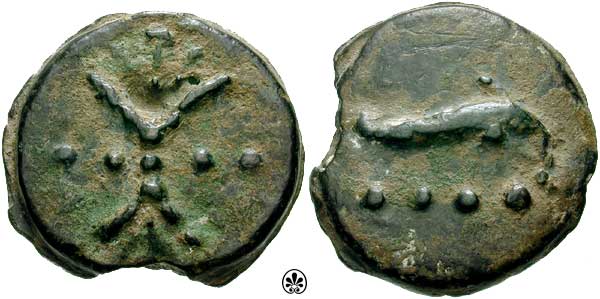
A triens coin (1/3 or 4/12 of an as). Note the four dots (····) indicating its value.
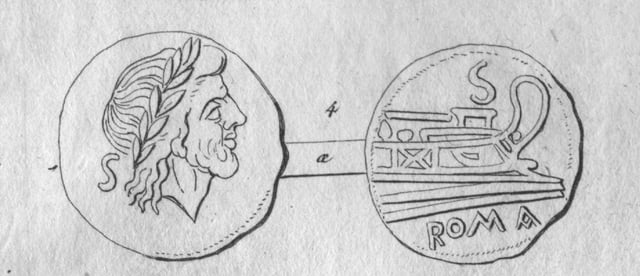
A semis coin (1/2 or 6/12 of an as). Note the S indicating its value.
Though the Romans used a decimal system for whole numbers, reflecting how they counted in Latin, they used a duodecimal system for fractions, because the divisibility of twelve (12 = 22 × 3) makes it easier to handle the common fractions of 1/3 and 1/4 than does a system based on ten (10 = 2 × 5). On coins, many of which had values that were duodecimal fractions of the unit as, they used a tally-like notational system based on twelfths and halves. A dot (·) indicated an uncia "twelfth", the source of the English words inch and ounce; dots were repeated for fractions up to five twelfths. Six twelfths (one half) was abbreviated as the letter S for semis "half". Uncia dots were added to S for fractions from seven to eleven twelfths, just as tallies were added to V for whole numbers from six to nine.[60]
Each fraction from 1/12 to 12/12 had a name in Roman times; these corresponded to the names of the related coins:
| Fraction | Roman numeral | Name (nominative and genitive) | Meaning |
|---|---|---|---|
| 1/12 | · | Uncia, unciae | "Ounce" |
| 2/12 = 1/6 | ·· or : | Sextans, sextantis | "Sixth" |
| 3/12 = 1/4 | ··· or ∴ | Quadrans, quadrantis | "Quarter" |
| 4/12 = 1/3 | ···· or ∷ | Triens, trientis | "Third" |
| 5/12 | ····· or ⁙ | Quincunx, quincuncis | "Five-ounce" (quinque unciae → quincunx) |
| 6/12 = 1/2 | S | Semis, semissis | "Half" |
| 7/12 | S· | Septunx, septuncis | "Seven-ounce" (septem unciae → septunx) |
| 8/12 = 2/3 | S·· orS: | Bes, bessis | "Twice" (as in "twice a third") |
| 9/12 = 3/4 | S··· orS∴ | Dodrans, dodrantis or nonuncium, nonuncii | "Less a quarter" (de-quadrans → dodrans) or "ninth ounce" (nona uncia → nonuncium) |
| 10/12 = 5/6 | S···· orS∷ | Dextans, dextantis or decunx, decuncis | "Less a sixth" (de-sextans → dextans) or "ten ounces" (decem unciae → decunx) |
| 11/12 | S····· orS⁙ | Deunx, deuncis | "Less an ounce" (de-uncia → deunx) |
| 12/12 = 1 | I | As, assis | "Unit" |
The arrangement of the dots was variable and not necessarily linear. Five dots arranged like (⁙) (as on the face of a die) are known as a quincunx, from the name of the Roman fraction/coin. The Latin words sextans and quadrans are the source of the English words sextant and quadrant.
Other Roman fractional notations included the following:
1/8 sescuncia, sescunciae (from sesqui- + uncia, i.e. 11⁄2 uncias), represented by a sequence of the symbols for the semuncia and the uncia.
1/24 semuncia, semunciae (from semi- + uncia, i.e. 1⁄2 uncia), represented by several variant glyphs deriving from the shape of the Greek letter sigma (Σ), one variant resembling the pound sign without the horizontal line (𐆒) and another resembling the Cyrillic letter Є.
1/36 binae sextulae, binarum sextularum ("two sextulas") or duella, duellae, represented by a sequence of two reversed Ss (ƧƧ).
1/48 sicilicus, sicilici, represented by a reversed C (Ɔ).
1/72 sextula, sextulae (1⁄6 of an uncia), represented by a reversed S (Ƨ).
1/144 = 12−2 dimidia sextula, dimidiae sextulae ("half a sextula"), represented by a reversed S crossed by a horizontal line (Ƨ).
1/288 scripulum, scripuli (a scruple), represented by the symbol ℈.
1/1728 = 12−3 siliqua, siliquae, represented by a symbol resembling closing guillemets (»).
Large numbers
A number of systems were developed for the expression of larger numbers that cannot be conveniently expressed using the normal seven letter symbols of conventional Roman numerals.
Apostrophus

"1630" on the Westerkerk in Amsterdam, with the date expressed in "apostrophus" notation.
One of these was the apostrophus,[61] in which 500 (usually written as "D") was written as IƆ, while 1,000, was written as CIƆ instead of "M".[21] This is a system of encasing numbers to denote thousands (imagine the Cs and Ɔs as parentheses), which has its origins in Etruscan numeral usage. The IƆ and CIƆ used to represent 500 and 1,000 most likely preceded, and subsequently influenced, the adoption of "D" and "M" in conventional Roman numerals.
In this system, an extra Ɔ denoted 500, and multiple extra Ɔs are used to denote 5,000, 50,000, etc. For example:
| Base number | CIƆ= 1,000 | CCIƆƆ= 10,000 | CCCIƆƆƆ= 100,000 | |
|---|---|---|---|---|
| 1 extraƆ | IƆ= 500 | CIƆƆ= 1,500 | CCIƆƆƆ= 10,500 | CCCIƆƆƆƆ= 100,500 |
| 2 extraƆs | IƆƆ= 5,000 | CCIƆƆƆƆ= 15,000 | CCCIƆƆƆƆƆ= 105,000 | |
| 3 extraƆs | IƆƆƆ= 50,000 | CCCIƆƆƆƆƆƆ= 150,000 |
Sometimes CIƆ was reduced to ↀ for 1,000. John Wallis is often credited for introducing the symbol for infinity (modern ∞), and one conjecture is that he based it on this usage, since 1,000 was hyperbolically used to represent very large numbers. Similarly, IƆƆ for 5,000 was reduced to ↁ; CCIƆƆ for 10,000 to ↂ; IƆƆƆ for 50,000 to ↇ; and CCCIƆƆƆ for 100,000 to ↈ.[62]
Vinculum
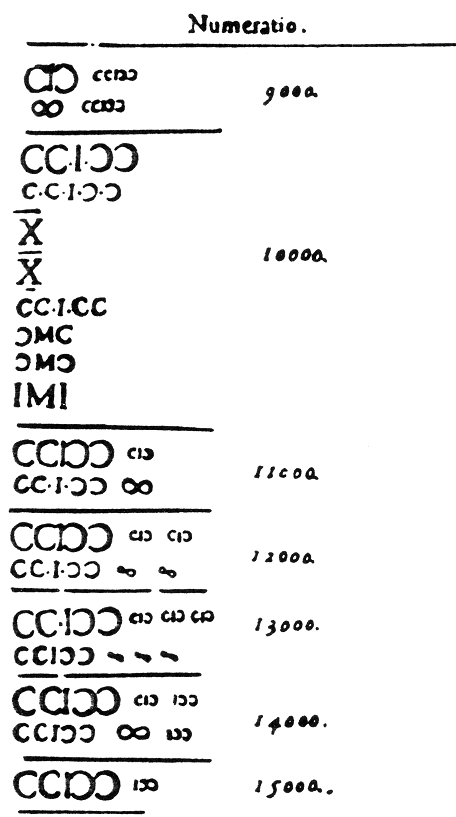
Page from a 16th-century manual, showing a mixture of apostrophus and vinculum numbers (see in particular the ways of writing 10,000).

Use of Roman numeral "I" (with exaggerated serifs) contrasting with the upper case letter "I".
Another system is the vinculum, in which conventional Roman numerals are multiplied by 1,000 by adding a "bar" or "overline".[62] Although mathematical historian David Eugene Smith disputes that this was part of ancient Roman usage,[63] the notation was certainly in use in the Middle Ages, and is sometimes suggested as a workable method for modern use, although it is not standardised as such.
Any hundreds, tens or units in the number are written in ordinary Roman numerals - but instead of M, MM or MMM, "barred" notation is used to express the thousands - which greatly expands the range of numbers expressible.
For instance:
IV = 4,000
IVDCXXVII = 4,627
XXV = 25,000
XXVCDLIX = 25,459
If this were ever to be applied consistently in our own times - then the main difficulty would be what to do with "M" - one way would be to do away with "M" altogether, except perhaps for CM (=900) - thus rendering MMXVIII as IIXVIII - or alternatively to retain "M" in its current usage, with the barred numerals starting at IV (=4,000). Retaining "M" would permit our numerals to run up to MMMCMXCIXCMXCIX (= 3,999,999).
Another inconsistent medieval usage was the addition of vertical lines (or brackets) before and after the numeral to multiply it by 10 (or 100): thus M for 10,000 as an alternative form for X. In combination with the overline the bracketed forms might be used to raise the multiplier to (say) ten (or one hundred) thousand, thus:
VIII for 80,000 (or 800,000)
XX for 200,000 (or 2,000,000)
Through all this, and whether any kind of vinculum notation or "barring" ought to be revived or not, this needs to be distinguished from the custom, once very common, of adding both underline and overline to a Roman numeral, simply to make it clear that it is a number, e.g. MCMLXVII (1967).
Unicode
The "Number Forms" block of the Unicode computer character set standard has a number of Roman numeral symbols in the range of code points from U+2160 to U+2188.[64] This range includes both upper- and lowercase numerals, as well as pre-combined characters for numbers up to 12 (Ⅻ or XII). One justification for the existence of pre-combined numbers is to facilitate the setting of multiple-letter numbers (such as VIII) on a single horizontal line in Asian vertical text. The Unicode standard, however, includes special Roman numeral code points for compatibility only, stating that "[f]or most purposes, it is preferable to compose the Roman numerals from sequences of the appropriate Latin letters".[65] The block also includes some apostrophus symbols for large numbers, an old variant of "L" (50) similar to the Etruscan character, the Claudian letter "reversed C", etc.
| Symbol | ↀ | ↁ | ↂ | ↅ | ↆ | ↇ | ↈ |
|---|---|---|---|---|---|---|---|
| Value | 1,000 | 5,000 | 10,000 | 6 | 50 | 50,000 | 100,000 |
See also
Egyptian numerals
Etruscan numerals
Greek numerals
Kharosthi numerals
Maya numerals
Roman abacus
Proto-writing
Roman numerals in Unicode
Pentimal system